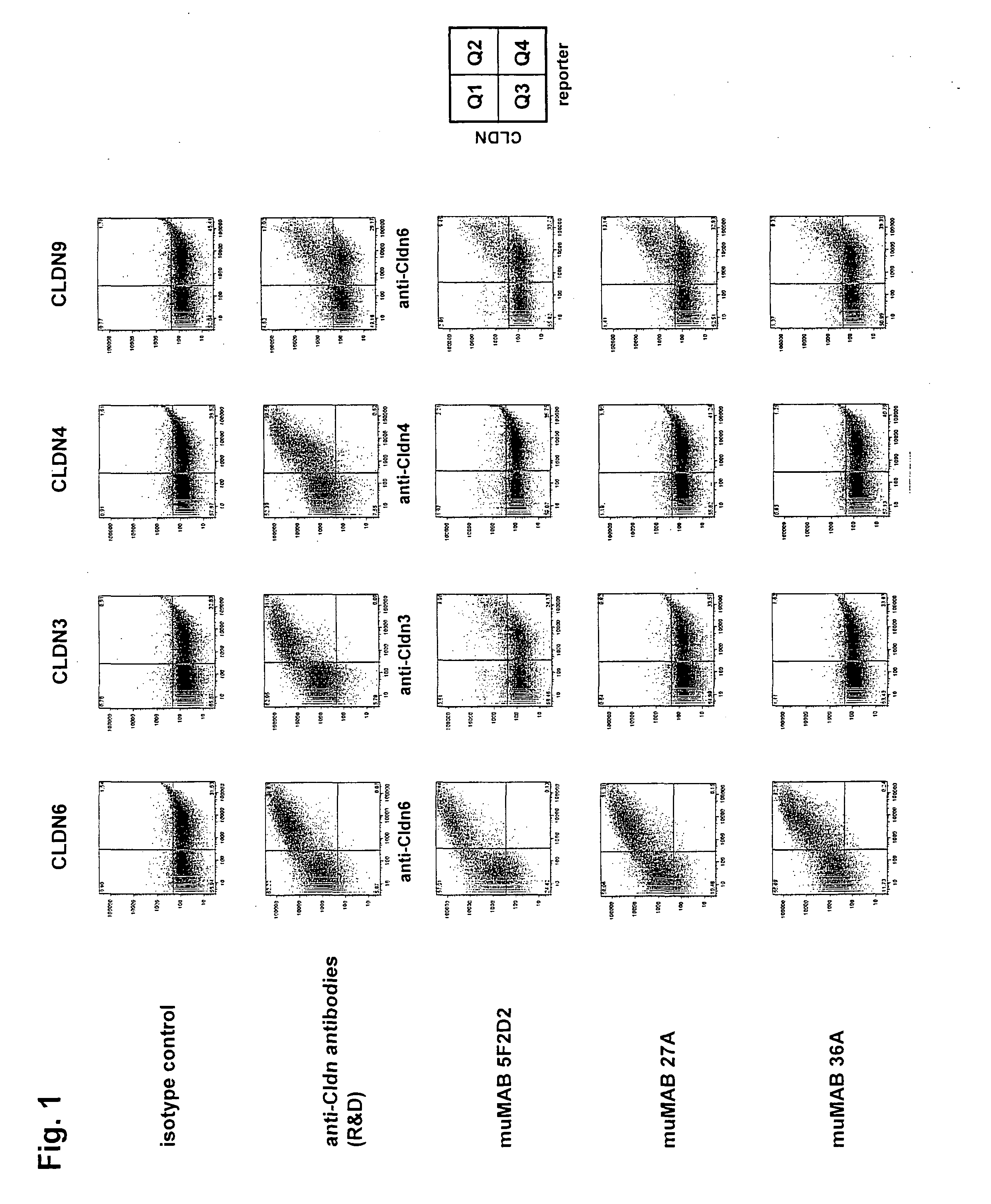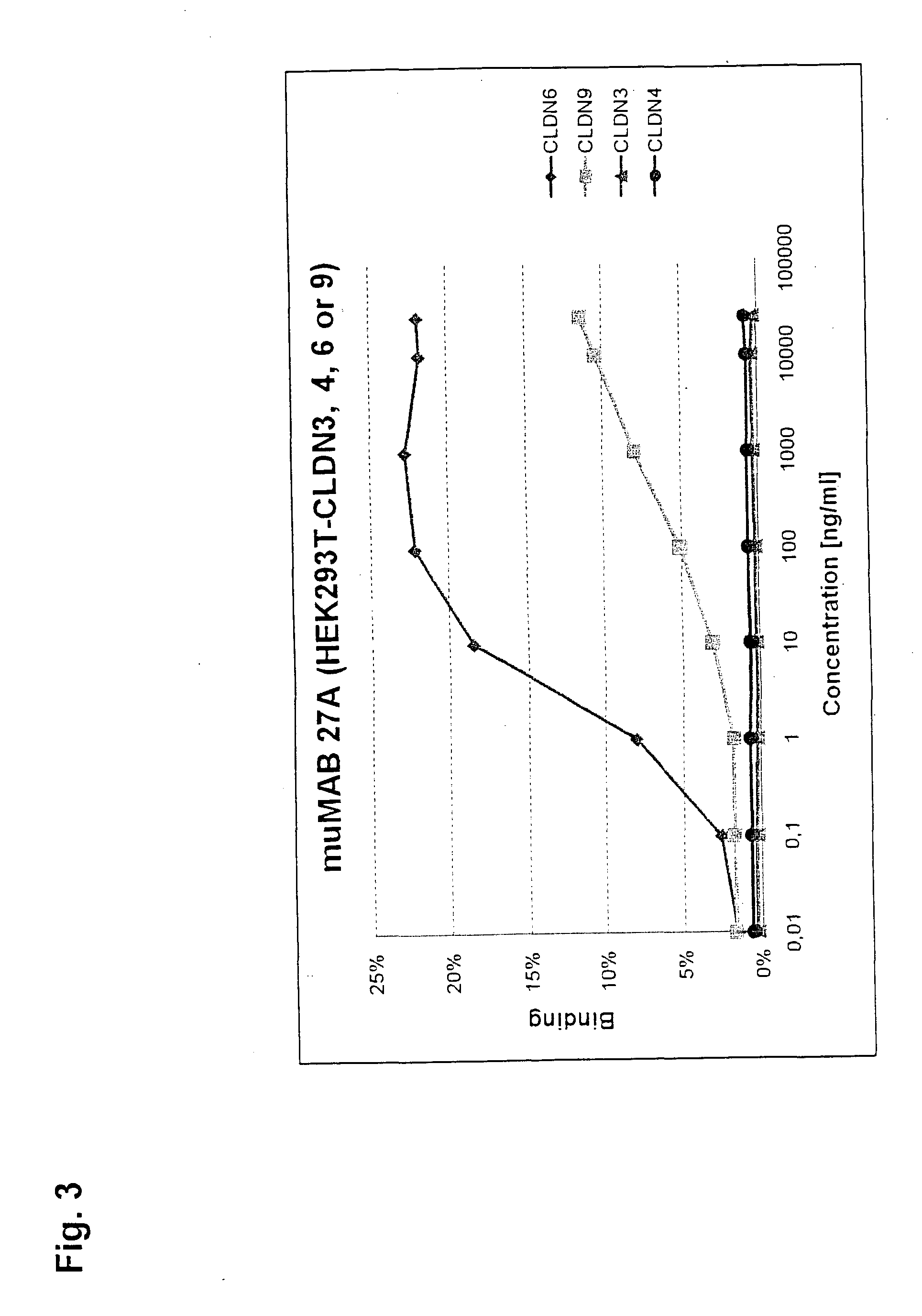Cancer therapy using cldn6 target-directed antibodies in vivo
- Summary
- Abstract
- Description
- Claims
- Application Information
AI Technical Summary
Benefits of technology
Problems solved by technology
Method used
Image
Examples
example 1
Materials and Methods
A. Generation of Murine Antibodies Against CLDN6
[0297]a. Generation of Expression Vectors Encoding Full Length CLDN6 and CLDN6 Fragments
[0298]A non-natural, codon-optimized DNA sequence (SEQ ID NO: 10) encoding full length CLDN6 (SEQ ID NO: 2) was prepared by chemical synthesis (GENEART AG, Germany) and cloned into the pcDNA3.1 / myc-His vector (Invitrogen, USA) yielding the vector p3953. Insertion of a stop codon allowed the expression of CLDN6 protein without being fused to the vector encoded myc-His tag. Expression of CLDN6 was tested by Western blot, flow cytometry and immunofluorescence analyses using commercially available anti-CLDN6 antibodies (ARP, 01-8865; R&D Systems, MAB3656).
[0299]In addition, a codon-optimized DNA sequence (SEQ ID NO: 11) coding for the putative extracellular domain 2 (EC2) fragment of CLDN6 (SEQ ID NO: 5) as a fusion with an N-terminal Ig kappa leader derived signal peptide followed by 4 additional amino acids to ensure a correct sig...
example 2
Binding of Antibodies Obtained According to the Invention to Claudins
[0318]The binding of the murine monoclonlal antibodies muMAB 5F2D2, 27A and 36A to human CLDN6, 3, 4 and 9 was analyzed by flow cytometry using HEK293T cells transiently expressing the corresponding human claudin. HEK293T were co-transfected with a fluorescence marker to distinguish between non-transfected (Q3 population) and transfected (Q4 population) cells. The antibody concentration used was the concentration that saturated binding to CLDN6 (25 μg / ml). The expression of human CLDN6, 3, 4 and 9 was confirmed with commercially available monoclonal antibodies against human Claudin-6 (R&D Systems, MAB3656), human Claudin-3 (R&D Systems, MAB4620) and human Claudin-4 (R&D Systems, MAB 4219).
[0319]MuMAB 5F2D2, 27A and 36A antibodies showed strong binding to cells expressing CLDN6, while they did not bind to cells expressing CLDN3 or CLDN4; see FIG. 1.
[0320]MuMAB 5F2D2, 27A and 36A antibodies were incubated at differen...
example 3
Effector Functions of Antibodies Obtained According to the Invention
[0323]The CDC activity of anti-CLDN6 antibodies was analysed using a luciferase-dependent assay to detect endogenous ATP within non-lysed cells. To this end, CHO-K 1 cells stably expressing human CLDN6 were treated with different concentrations of MuMAB 5F2D2, 27A or 36A or anti-CLDN6 (R&D Systems, MAB3656) as an internal control.
[0324]MuMAB 5F2D2 showed CDC activity in a dose-dependent manner; see FIG. 6. MuMAB 27A exhibited dose-dependent CDC activity whereas muMAB 36A was not able to induce CDC in vitro; see FIG. 7.
[0325]The ability of the chimeric anti-CLDN6 antibody chimAB 5F2D2 to induce antibody-dependent cell-mediated cytotoxicity (ADCC) on endogenously CLDN6 expressing NEC8 and NEC8 LVTS2 54 (CLDN6 knock-down) cells was determined; see FIG. 8. The chimeric anti-CLDN6 antibody chimAB 5F2D2 and the positive control Herceptin induced ADCC on NEC8 cells with effector cells of two different donors in a dose depe...
PUM
| Property | Measurement | Unit |
|---|---|---|
| Composition | aaaaa | aaaaa |
| Cytotoxicity | aaaaa | aaaaa |
Abstract
Description
Claims
Application Information
 Login to View More
Login to View More - R&D
- Intellectual Property
- Life Sciences
- Materials
- Tech Scout
- Unparalleled Data Quality
- Higher Quality Content
- 60% Fewer Hallucinations
Browse by: Latest US Patents, China's latest patents, Technical Efficacy Thesaurus, Application Domain, Technology Topic, Popular Technical Reports.
© 2025 PatSnap. All rights reserved.Legal|Privacy policy|Modern Slavery Act Transparency Statement|Sitemap|About US| Contact US: help@patsnap.com



